Cathedral of Christ the King, Katowice
Church buildings with domesChurches in KatowiceEurope Roman Catholic cathedral stubsPolish church stubsRoman Catholic cathedrals in Poland

Archikatedra Chrystusa Króla w Katowicach (English: Archcathedral of Christ the King in Katowice) is a classicist archcathedral in Katowice-Śródmieście, Katowice, Poland. Constructed between 1927 and 1955, the Archcathedral of Christ the King is the largest archcathedral in Poland.
Excerpt from the Wikipedia article Cathedral of Christ the King, Katowice (License: CC BY-SA 3.0, Authors, Images).Cathedral of Christ the King, Katowice
Plebiscytowa, Katowice
Geographical coordinates (GPS) Address Phone number External links Nearby Places Show on map
Geographical coordinates (GPS)
| Latitude | Longitude |
|---|---|
| N 50.251388888889 ° | E 19.018611111111 ° |
Address
Archikatedra pw. Chrystusa Króla w Katowicach
Plebiscytowa 46a
40-025 Katowice (Śródmieście)
Silesian Voivodeship, Poland
Open on Google Maps










